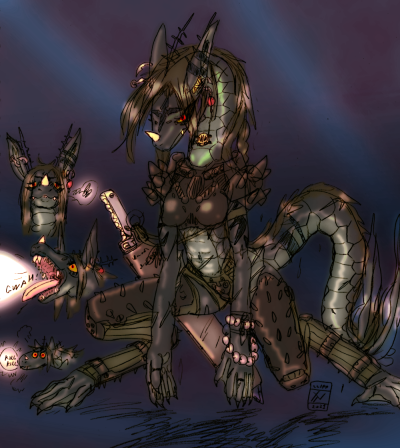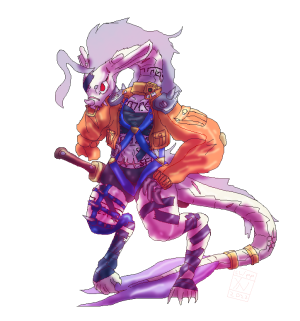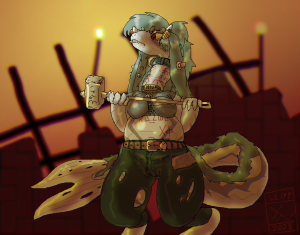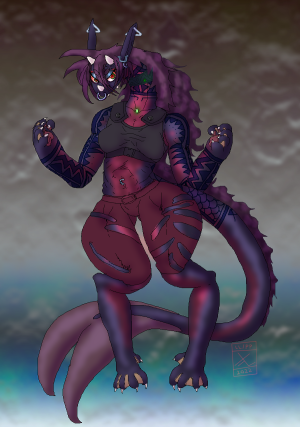Sidebar
Table of Contents
Silanbar
Cunning, tenacious, and filled with a certain practical savagery, the Silanbar are a technologically primitive but physically large and imposing serpentine race. Originally getting where they are by serving as warrior-thralls to greater races, their society now spreads as highly independent pirates and renegades within the borders of other civilisations.
Fighting and besting one another is at the core of their culture, leading them to view almost everyone else as 'frenemies' at best, even their own kind. The Kuvexians are seen as nigh-mythical deities due to raising them up from their squalid beginnings, but after losing a war with the Yamatai Star Empire, the balance of power seems set to shift…
General Information
- Homeworld: Skorlamech
- Population: 4.3 billion
- Government: Various houses and mercenary groups approved by Quallox Vaibal in Kuvexian Territory, but many others without. Groups operating under the Sood Zadra government are the most relevant in the Kikyo Sector.
- First contract with the Interstellar Kingdom Of Kuvexia in YE 28.
History
The Silanbar were uplifted from a primitive state by the Kuvexians in very recent memory, using the typical method of simply turning up and establishing peace through superior firepower. The creatures of the swampy planet 'Skorlamech' always had a warlike and grotesquely independent culture, having discovered metal crafting through acid-etching, but not actual fire or forging. Changing their authority from one of their native clan-kings to a Kuvexian businessman was actually pretty natural, since anyone and everyone was looking for an edge with which to gain personal power.
It was thus that they became fashionable, tribalistic bodyguards for a time within Arm 06 / Kuvexian territory, though applicants were often chosen for their aesthetic value and obedience, rather than actual strength of arms. Regardless, independent travellers started to make their way out from the harsh working conditions of the system's economic space stations, picking up general zero-g life skills rather quickly because of their master's irresponsible and self-serving ways.
They are still rare in the Kikyo sector, but are quite happy living in the very lowest wrungs of fringe or Nepleslian societies, digging through trash heaps and sewers. Worse trained than ID-SOL but cheaper to hire and harder living, it's perhaps natural that they have started to appear as mercenaries and bodyguards within various human criminal organisations, as well as the upstart fiefdom of Sood Zadra.
Physiology
Warm blooded quasi-reptilian creatures ranging between six and nine foot tall, with particularly long necks and tails. Their mermaid-like qualities of smooth skin, long hair and frilly tails can fool a person into thinking they are graceful dragons from a photograph; This rather glosses over their skulking, awkward gait on land, webbed hands and feet equipped with barbed talons, and a propensity to sweat a thick hagfish-like mucus when directly threatened or captured.
Strength and toughness is rather above human norms, able to break bones, lift fridges or flip a land-car when enraged. Running and climbing are also a bit faster, but requires all four limbs. Exact body proportions and weight depend on the individual.
The face is a long rather triangular snout, with two side-mounted eyes, a many-fanged maw, and huge angular ears. Almost all have stubby singular horn at the end of the nose, and an additional pair on the back of their head.
Most common colours include white, grey, grey-purple or grey-blue scales, generally with a darker underside. The eyes tend to be amber, red or orange, rarely green.
Despite being obviously adapted for aquatic movement, Silanbar do not have gills and cannot breathe underwater. They can hold their breath for about an hour, depending on the physical fitness of the individual. The climate they come from also matters, as warm swamp Silanbar are thinner and more lean, whilst cold water 'iceberg' Silanbar have shorter limbs and more body fat.
They are not particularly gender dimorphic, appearing rather sleek and androgynous. Some of them seem confused about the concept of gender entirely.
Diet
Silanbar are voracious and competitive omnivores, capable of eating most organic matter, to the point were cooked meat was unknown to them before alien intervention. Much like snakes and crocodiles, they can eat a large amount and then hibernate in a period of low activity for up to six months before requiring food again. This does not stop them from eating way more than they need to, on a regular basis.
Environment
They prefer swampy and humid environments, but can actually live just about anywhere, from boiling to freezing temperatures (depending on the specific individual's anatomy). Because of their semi-aquatic nature, they are also surprisingly resistant to hypoxia in low-oxygen environments.
All of this said, their sweat-slime reflex means that stressing them out makes them dehydrate a lot faster. Long term comfort relies on them having a bath of water to lay down in.
Life Cycle
Breeding is an awkward subject, and not one that they like to discuss with outsiders much. Their entire 'parenting method' entails a female's natural urge to hide the eggs everywhere dark and dry (in vents, desk drawers, down the back of the seat cushions…) It takes eight weeks for the eggs to hatch, after which the spawnlings will grow about a foot per year until reaching maximum size.
Nobody really knows the maximum age range for the Silanbar. An individual generally needs to remain independent to survive in their society, and will not admit how old they are even if they are actually counting, for fear of appearing weak and vulnerable.
Psychology
Motivation and Emotion
Silanbar have a certain cold cunning and logic that makes them inherently pragmatic and disloyal. They only believe in things that they personally witness, and can be highly gullible, due to rarely lying themselves (Though a garbage lizard who has figured this out is dangerous, indeed). They don't trust acts of kindness easily, and are utterly baffled by alien concepts of states, boarders and monarchs.
Generally if they are going to fight you, they'll actively tell you beforehand- Stabbing somebody in the back doesn't prove how strong you are, but stabbing your best friend in the front proves you weren't just relying on their strength to get by. This is actually seen as a positive interaction, constantly roughhousing and fighting each other to prove that they aren't just taking the 'friendship' for granted.
To be worth loyalty is to show obvious signs of personal cunning, power, intelligence and voracity; All other poetic reasoning is alien.
Sexuality and Love
…Of course, the flip side of this is that they can be come actively obsessed with those they see as special, smart or genetically strong. It can go way past the point of idol worship in some cases, a lop-sided arrangement where one 'superior' individual might have several 'inferior' lovers. This can and does extend to alien races.
Sexuality is an extremely loud and aggressive affair, with both 'lovers' constantly demanding that they hate each other, and that they are the one who is 'winning'.
Culture
Language
Their language is called Hureog. It's a complex system of guttural raspy noises, hand signals and body movements, that's not really possible for a human being to pronounce, and has many regional dialects even then.
Considering their anatomy has only very basic vocal cords, most spacefaring Silanbar are equipped with auto-translation throat implants so they can understand and pronounce human words in turn, though their skill at it may vary (It's only a basic auto-translation, how much effort is involved is up to the specific individual).
Naming
They like extremely long phonetic names with lots of 'Z's 'K's and 'Q's, with a vowel every other letter, such as “Zuruzala” or “Kuraqazu”- They are awkward to pronounce because they were supposed to be danced at each other and not spoken. Generally the first name is one given to them by their earliest childhood friends, frequently the name of an animal who's personality they most resemble.
Generally they have three other levels of name beyond this, which goes (First Name) → (Region of Birth) → (Mother's Name) → (Early Mentor's Name), for instance “Vossamar Kurquad Kygyrr Blexen” or “Gyrid Holgi Ygrmar Dyiad”.
Because their record keeping is terrible, however, some of these details may be missing, resulting in much shorter names.
Attire
Ragged and rag-tag, Silanbar basically just scavenge whatever is on hand and make their own garments. There is a certain talismanic, tribalistic quality to the way they just throw whatever they can find onto themselves. Many of them have angular body markings, which were originally a Kuxevian affectation; It was supposed to be a way to catalogue and record the identities of officially sanctioned and trained Silanbar auxiliaries, but counterfeit markings and overly enthusiastic ritualistic embracement of the practice made it impossible to track genuine data from falsehood.
Religion
Silanbar find the whole concept far too suspicious, and generally dislike anyone pedalling it on the spot.
Society
Silanbar have a strong sense of “survival of the fittest”, but also a surprisingly strong contrasting sense of “esprit de corps”. In other words, they genuinely want to serve a worthwhile master, but will backstab them the moment they detect hypocrisy, laziness or incompetence.
There are technically no laws or police force, only houses lead by singular ruling individuals above several layers of serfs in descending status. Hereditary power does not exist, and though a particular harsh master is perfectly capable of brutalizing or killing their charges, to go overboard is to invite mutiny and replacement. The actual violence and savagery that goes on is, thus, actually more like mob mentality. Telling someone you are going to assassinate them actually makes it more culturally acceptable than trying to conceal it, since who trusts a liar?
The goals of houses are thus varied as the stars in the sky. Some pursue martial prowess, some pursue technological hoarding, whilst others are dedicated nomads and explorers.
They have a very loose concept of states and borders, preferring to keep to slightly less loose concepts of family and bloodlines. A child basically raises themselves by scavenging, finding odd jobs and making themselves useful, eventually earning the right to be treated as a true member of society. The system requires at least five sponsors, which in some ways makes these individuals adoptive parents.
As a larger extended family unit, the maximum span of which generally covers a city-sized community, these clans directly compete and fight with other clans over resources or technology, and sometimes grudges based on who has the genetically superior stock. These conflicts tend to end with one side absorbing the other rather than actual genocide, once the writing is on the wall.
Either way, inter-clan animosity is now seen as very old fashioned. Alien races are clearly better targets for their aggression, generally reducing old grudges to simple avoidance of one another. There are a great many who now travel the stars alone, ambitiously seeking fortune with other aliens, and jump-sharking the old caste system entirely.
OOC Notes
Primitive Polygon created this article on 2022/03/16 16:24.
Page Tools
Terms of Service - Privacy Policy




